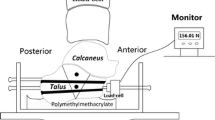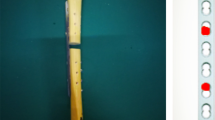Abstract
Purpose
Calcaneal fracture treatment is challenging. Implant failure is one problem encountered with plate osteosynthesis. Therefore a new “bionic” plate was developed, which imitates the trabecular orientation of the human calcaneus. The aim of this study was to biomechanically test this new plate in comparison to a “standard” calcaneal locking plate and present the first clinical results.
Methods
Six “bionic” and six “standard” calcaneal plates were biomechanically tested for stability and fatigue using synthetic calcanei. Between 4/2012 and 04/2013 the first ten consecutive patients meeting the inclusion criteria were treated with the novel implant and followed-up clinically and radiologically. The 12-month follow-up results are reported.
Results
The “bionic” plate design showed significantly higher fatigue life (68 %), load to failure (100 %) and reduced displacement under load (90 %) if compared to a “standard” locking plate. No major complications were seen; most notably there was no implant failure and no loss of reduction. Mean AOFAS/hindfoot score was 79 (69–86).
Conclusions
The novel plate architecture offers higher stability and load tolerance while being more resistant to fatigue. The preliminary clinical results are promising. These findings will have to be proved by larger clinical trials.





Similar content being viewed by others
References
Rammelt S, Zwipp H (2004) Calcaneus fractures: facts, controversies and recent developments. Injury 35(5):443–461. doi:10.1016/j.injury.2003.10.006
Sanders R (2000) Displaced intra-articular fractures of the calcaneus. J Bone Joint Surg Am 82(2):225–250
Kinner B, Schieder S, Muller F, Pannek A, Roll C (2010) Calcaneocuboid joint involvement in calcaneal fractures. J Trauma 68(5):1192–1199. doi:10.1097/TA.0b013e3181b28b8c
Schepers T, Backes M, Schep NW, Carel Goslings J, Luitse JS (2013) Functional outcome following a locked fracture-dislocation of the calcaneus. Int Orthop 37(9):1833–1838. doi:10.1007/s00264-013-2065-4
Benirschke SK, Sangeorzan BJ (1993) Extensive intraarticular fractures of the foot. Surgical management of calcaneal fractures. Clin Orthop Relat Res 292:128–134
Boack DH, Wichelhaus A, Mittlmeier T, Hoffmann R, Haas NP (1998) Therapy of dislocated calcaneus joint fracture with the AO calcaneus plate. Chirurg 69(11):1214–1223
Zwipp H, Rammelt S, Barthel S (2004) Calcaneal fractures–open reduction and internal fixation (ORIF). Injury 35(Suppl 2):SB46–SB54. doi:10.1016/j.injury.2004.07.011
Jiang N, Lin QR, Diao XC, Wu L, Yu B (2012) Surgical versus nonsurgical treatment of displaced intra-articular calcaneal fracture: a meta-analysis of current evidence base. Int Orthop 36(8):1615–1622. doi:10.1007/s00264-012-1563-0
Arora R, Lutz M, Fritz D, Zimmermann R, Oberladstatter J, Gabl M (2005) Palmar locking plate for treatment of unstable dorsal dislocated distal radius fractures. Arch Orthop Trauma Surg 125(6):399–404. doi:10.1007/s00402-005-0820-8
Ehlinger M, Adam P, Bonnomet F (2010) Minimally invasive locking screw plate fixation of non-articular proximal and distal tibia fractures. Orthop Traumatol Surg Res 96 (7):800–809. doi:10.1016/j.otsr.2010.03.025
Lee T, Blitz NM, Rush SM (2008) Percutaneous contoured locking plate fixation of the pilon fracture: surgical technique. J Foot Ankle Surg 47(6):598–602. doi:10.1053/j.jfas.2008.06.009
Illert T, Rammelt S, Drewes T, Grass R, Zwipp H (2011) Stability of locking and non-locking plates in an osteoporotic calcaneal fracture model. Foot Ankle Int 32 (3):307–313. doi:10.3113/FAI.2011.0307
Richter M, Gosling T, Zech S, Allami M, Geerling J, Droste P, Krettek C (2005) A comparison of plates with and without locking screws in a calcaneal fracture model. Foot Ankle Int 26(4):309–319
Kinner B, Roll C, Dienstknecht TM (2006) N Plattenbrüche nach winkelstabiler Calcaneusosteosynthese. In: Deutscher Kongress für Orthopädie und Unfallchirurgie. 70. Jahrestagung der Deutschen Gesellschaft für Unfallchirurgie, 92. Tagung der Deutschen Gesellschaft für Orthopädie und Orthopädische Chirurgie und 47. Tagung des Berufsverbandes der Fachärzte für Orthopädie, Berlin. German Medical Science
Richter M, Droste P, Goesling T, Zech S, Krettek C (2006) Polyaxially-locked plate screws increase stability of fracture fixation in an experimental model of calcaneal fracture. J Bone Joint Surg (Br) 88(9):1257–1263. doi:10.1302/0301-620X.88B9.17822
Sanders R, Fortin P, DiPasquale T, Walling A (1993) Operative treatment in 120 displaced intraarticular calcaneal fractures. Results using a prognostic computed tomography scan classification. Clin Orthop Relat Res 290:87–95
Zwipp H, Rammelt S, Barthel S (2005) Fracture of the calcaneus. Surgical technique. Unfallchirurg 108(9):749–760. doi:10.1007/s00113-005-1001-5
Paley D, Hall H (1993) Intra-articular fractures of the calcaneus. A critical analysis of results and prognostic factors. J Bone Joint Surg Am 75(3):342–354
Gefen A, Seliktar R (2004) Comparison of the trabecular architecture and the isostatic stress flow in the human calcaneus. Med Eng Phys 26(2):119–129. doi:10.1016/j.medengphy.2003.10.003
Lin PP, Roe S, Kay M, Abrams CF, Jones A (1998) Placement of screws in the sustentaculum tali. A calcaneal fracture model. Clin Orthop Relat Res 352:194–201
Blake MH, Owen JR, Sanford TS, Wayne JS, Adelaar RS (2011) Biomechanical evaluation of a locking and nonlocking reconstruction plate in an osteoporotic calcaneal fracture model. Foot Ankle Int 32 (4):432–436. doi:10.3113/FAI.2011.0432
Gaskill T, Schweitzer K, Nunley J (2010) Comparison of surgical outcomes of intra-articular calcaneal fractures by age. J Bone Joint Surg Am 92(18):2884–2889. doi:10.2106/JBJS.J.00089
Kinner B, Tietz S, Muller F, Prantl L, Nerlich M, Roll C (2011) Outcome after complex trauma of the foot. J Trauma 70(1):159–168. doi:10.1097/TA.0b013e3181fef5eb, discussion 168
Zwipp H, Rammelt S, Amlang M, Pompach M, Durr C (2013) Operative treatment of displaced intra-articular calcaneal fractures. Oper Orthop Traumatol 25(6):554–568. doi:10.1007/s00064-013-0246-3
Backes M, Schepers T, Beerekamp MS, Luitse JS, Goslings JC, Schep NW (2014) Wound infections following open reduction and internal fixation of calcaneal fractures with an extended lateral approach. Int Orthop 38(4):767–773. doi:10.1007/s00264-013-2181-1
Author information
Authors and Affiliations
Corresponding author
Rights and permissions
About this article
Cite this article
Kinner, B., Kerschbaum, M., Bley, C. et al. Bionic plate design for calcaneal fracture treatment. A biomechanical analysis and first clinical results. International Orthopaedics (SICOT) 39, 111–117 (2015). https://doi.org/10.1007/s00264-014-2561-1
Received:
Accepted:
Published:
Issue Date:
DOI: https://doi.org/10.1007/s00264-014-2561-1




